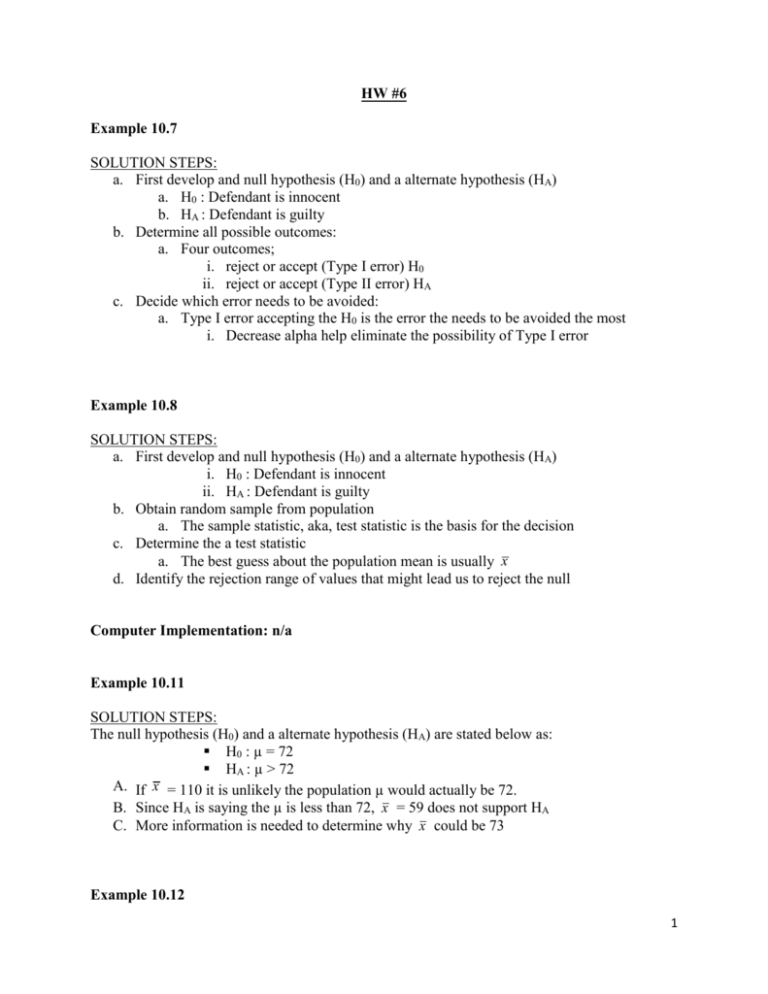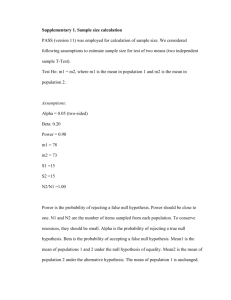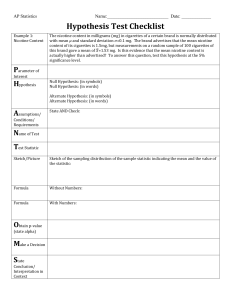HW #6 Example 10.7 SOLUTION STEPS: First develop and null
advertisement

HW #6 Example 10.7 SOLUTION STEPS: a. First develop and null hypothesis (H0) and a alternate hypothesis (HA) a. H0 : Defendant is innocent b. HA : Defendant is guilty b. Determine all possible outcomes: a. Four outcomes; i. reject or accept (Type I error) H0 ii. reject or accept (Type II error) HA c. Decide which error needs to be avoided: a. Type I error accepting the H0 is the error the needs to be avoided the most i. Decrease alpha help eliminate the possibility of Type I error Example 10.8 SOLUTION STEPS: a. First develop and null hypothesis (H0) and a alternate hypothesis (HA) i. H0 : Defendant is innocent ii. HA : Defendant is guilty b. Obtain random sample from population a. The sample statistic, aka, test statistic is the basis for the decision c. Determine the a test statistic a. The best guess about the population mean is usually x d. Identify the rejection range of values that might lead us to reject the null Computer Implementation: n/a Example 10.11 SOLUTION STEPS: The null hypothesis (H0) and a alternate hypothesis (HA) are stated below as: H0 : µ = 72 HA : µ > 72 A. If x = 110 it is unlikely the population µ would actually be 72. B. Since HA is saying the µ is less than 72, x = 59 does not support HA C. More information is needed to determine why x could be 73 Example 10.12 1 SOLUTION STEPS: The null hypothesis (H0) and a alternate hypothesis (HA) are stated below as: H0 : µ = 72 HA : µ > 72 α = .05 Determine the z-score of x to see if 73 is sufficiently greater than 72 to reject H0 o The sample mean and standard deviation are valid if the null is true z = x - µ(72) / s / √n z = 1.645 = critical value All values at or above 1.645 (standard deviations / critical value) are in the null rejection region Computer Implementation: n/a Example 10.16 SOLUTION STEPS: The null hypothesis (H0), alternate hypothesis (HA), and significance value are stated as: H0 : µ = .5 HA : µ ≠ .5 α = .05 Determine the rejection range by using the z-score of x o The sample mean and standard deviation are valid if the null is true z = x - µ(.5) / s / √n z = -3.77 /2 = -1.96 (left tail) and 1.96 (right tail) The results a Type I error could occur with a probability of α = .05 Example 11.10 SOLUTION STEPS: The null hypothesis (H0), alternate hypothesis (HA), and significance value are stated as: H0 : µ1 - µ2 = 0 HA : µ1 - µ2 ≠ 0 α = .01 Let µ1 = mean of stayers and Let µ2 = mean leavers Determine the rejection range by the z value o Two tailed sample - Reject null if z is greater than z value divided by 2 (tails) z value of .005 = 2.58; z less than 2.57 and z greater than -2.58 z = x 1 – x 2 / √s12/n1 + s22/n2 = 5.68 Verify if the z value is outside the rejection range 2 o Z = 5.68 is in the rejection region – The mean of the stayers is significantly different than the leavers The probability of Type I error is α = .01 Example 11.12 SOLUTION STEPS: The null hypothesis (H0), alternate hypothesis (HA), and significance value are stated as: H0 : µ1 - µ2 = 0 HA : µ1 - µ2 > 0 α = .05 Let µ1 = mean of type A and Let µ2 = mean of type B t distribution – sample is small; n = 10 o (n - 1 ) = (10-1) = 9 degrees of freedom t > t.05 = 1.833 Determine the test statistic o Calculate the difference (d), in duration of use, for the shoes and for each jogger (table 11.4) o Calculate the mean difference and the standard deviation of the sample Use the results from computer programs like Excel (t-distribution) or ASP we find that: o Mean difference = 2.6 o Standard deviation = √13.3778 = 3.66 t = d – D0 / sd / √n = 2.25 The test statistic exceeds the t.05 = 1.833 critical value, there is sufficient evident to indicate the mean difference of A exceeds the mean for B Computer Implementation: The use of Excel’s t-test provided the same information as ASP. Less information was needed. I type the chart into Excel including the headings and all information was computed. Nevertheless, both programs came to the same conclusion: A mean exceeds the mean for B. Example 11.15 SOLUTION STEPS: The null hypothesis (H0), alternate hypothesis (HA), and significance value are stated as: H0 : 𝜎2 = .01 HA : σ2 < .01 Normally distributed Alpha = .05 Determine test statistic 3 o Chi Square = (n-1)s2 / 𝜎20 Find rejection range o Reject null if chi-square < 3.32511 (to the right) & (to the left) chi-square.95 =1.66 The test statistic chi-square = 1.66 and is less than 3.32511, therefore we reject the null and accept the alternate Example 11.17 SOLUTION STEPS: The null hypothesis (H0), alternate hypothesis (HA), and significance value are stated as: H0 : 𝜎21 / σ22 = 1 HA : 𝜎21 / σ22 ≠ 1 Alpha = .10 Determine test statistic o F = s21 / s22 = 2.27 Determine rejection region for a two tailed F test o Reject null if F > 3.79 Output concludes we should fail to reject the null with a certainty of alpha = .10 o Data did not support a difference between the variances To further support the claim the value of Type II error needs to be figured. 4







